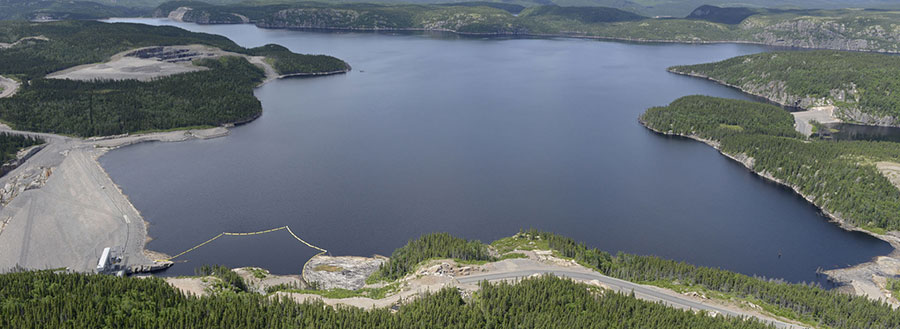Québec hydropower: clean, renewable and low in GHG emissions
Close to 100% of the electricity Hydro-Québec distributes to its customers is generated from renewable resources, which means there are few or no greenhouse gas (GHG) emissions.
Almost all of Hydro-Québec’s electricity supply comes from renewable energies generated in Québec, either by Hydro-Québec itself or by independent power producers, as well as from the hydropower generated by Churchill Falls generating station, which is located in Labrador and partly owned by Hydro-Québec. This means that less than 1% of the electricity consumed in Québec comes from other out-of-province sources.
Main grid supply in real time
Electricity demand in Québec varies depending on the time and the season.
Over the course of a day, there are two peaks in demand: one in the morning when people are getting ready for work, and one in the late afternoon/early evening when people are busy doing lots of things.
The electricity sources used to meet this demand can also vary.
One thing remains constant however: over 99% of our electricity is generated, on an annual basis, from renewable sources.
This data is provided in real time. It is part of the open data we make accessible to third parties who may wish to use it within the scope of the energy transition.

Your Mission
Create your own energy mix to come up with 9,000 megawatts in this simulation game.
Game onHydropower is internationally recognized as renewable energy
In 2004, the International Conference for Renewable Energies, held in Bonn, Germany, brought together officials and other delegates from 154 countries, including Australia, Canada, China, Denmark, France, Italy, Japan, Mexico, Norway, Spain, Switzerland, the United States and Vietnam. Participants agreed that “renewable energies” included solar, wind, hydropower, biomass (including biofuels) and geothermal.
In September 2009, the 33rd Conference of New England Governors and Eastern Canadian Premiers recognized hydropower as a renewable energy source and stated that American and Canadian federal legislation should do the same.
On June 4, 2010, Vermont passed a law, titled An Act Relating to Renewable Energy, which recognizes hydropower as a clean, renewable form of energy, regardless of the generating facility’s capacity. In August 2010, Hydro-Québec signed a long-term (2012–2038) supply contract with two large Vermont-based power distributors.
In November 2010, the U.S. National Association of Regulatory Utility Commissioners (representing the state public service commissioners who regulate essential utility services, including energy, telecommunications, and water) recognized that hydropower facilities can be valuable clean and renewable energy resources.
The Energy Information Administration of the U.S. Department of Energy classifies hydropower as a renewable energy source. In 2016, the United States generated 15% of its energy from renewable sources, of which 42% was hydropower.
Finally, in November 2017, the U.S. Energy Policy Act was amended to recognize all forms of hydropower as renewable energy sources. The amendment stems from the Hydropower Policy Modernization Act of 2017 adopted by the U.S. House of Representatives.
Our reservoir generating stations present numerous advantages for North America’s energy production

Since electricity needs to be generated at the very moment consumers use it, generation must constantly be adjusted according to demand. This is a real challenge for power utilities worldwide!
In this context, hydropower plants with reservoirs have a sizeable advantage: they can accumulate water when electricity demand is low, and use it later when demand rises.
Our generating fleet is made up of 63 hydropower generating stations and 28 reservoirs.
Our reservoirs help reduce the environmental impact of power generation in the U.S. Northeast
With the states in the U.S. Northeast clearly looking to reduce the GHG emissions caused by power generation, our exports can play a key role in this energy transition.
In fact, when Québec hydropower is exported to neighboring states, it allows these areas to generate less power from natural gas, oil and coal. Every year, our exports prevent the GHG emissions equivalent to that of a few million vehicles.
In addition, our reservoirs can facilitate the integration of variable renewables, such as wind and solar, which are increasingly popular in northeastern states. Energy from the wind and sun is not always available when power demand is greatest. Conversely, demand may not be high when wind and solar generation are peaking. To ensure the integration of these generating options onto the grid, they need to be combined with a stable and readily dispatchable energy source. In the U.S., that source is usually natural gas, but hydropower is a more efficient and more sustainable choice. Thanks to hydropower’s flexibility, when our neighbors have a surplus of power, we can import it to maintain the water storage levels in our reservoirs, and export the stored energy later when our neighbors’ demand outstrips their generating capacity.
GHG Emission Estimates – Power Generation Options Based on Life-cycle Analysis (g CO2 eq./kWh)
-
28
 Québec Hydropower
Québec Hydropower -
14
 Wind
Wind -
8
 Nuclear
Nuclear -
64
 Photovoltaic Solar
Photovoltaic Solar -
608
 Thermal
Thermal
Natural Gas -
880
 Thermal
Thermal
Oil -
880
 Thermal
Thermal
Coal







